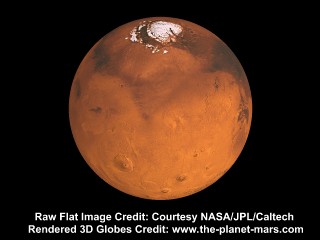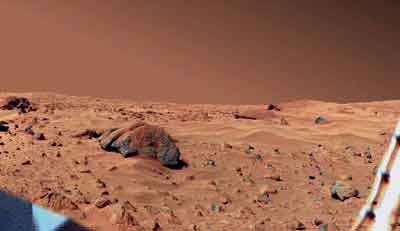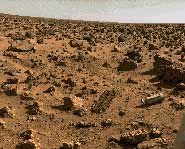|

QueSPER Research Projects
Planets in the Solar System
Mars
Mars Mars Mars
 
|
|
MARS |
Mars
Printout
 |
How far is Mars
from the Sun?
 |
Mars is the fourth closest planet to the Sun. |
 | It is between
Earth and Jupiter. |
 |
Mars has an average
distance of 141.6 million miles or 229 million kilometers from the
Sun. |
 |
Mars
is 1.52 AU* from the Sun. |
|
 |
How big is Mars?
 |
Mars is
about half the size of the Earth; it is about .53 the size of Earth. |
 | Mars is the seventh
largest planet. This means that only one planet is smaller,
Mercury. |
 | Mars has a diameter of
4,222 miles (6800 kilometers), about half that of Earth. |
|
 |
Why is this
planet named Mars?
|
 | What
does Mars look like?
 |

|
| Picture of the surface of Mars |
Picture of the surface of Mars |
 | Mars is
called the Red Planet because it has a red or pink hue when viewed from
Earth. It is this color thanks to the large
amounts of dust that cover it. The dust, an iron-rich material that
forms as a product of weathering, coats the planet like a mantle of
rust. |
 | Mars has been known to
humans since ancient times. The
Egyptians name for Mars is Har Decher which means, The Red
One. |
 |
Mars has two moons named Phobos and
Deimos. The moons are named after the mythical horses that drew
the chariot of the Roman war god Mars. |
 |
We are learning more about the surface of
the planet all the time. |
 |
We now know that Mars has the largest
volcano in the solar system. It is called Olympus Mons and is three times higher that Mount
Everest, Earth's highest mountain. |
 |
Mars has a canyon
that would stretch from California to New York. |
 |
Mars has evidence
of liquid water and huge floods. Liquid water is thought to have
disappeared on Mars about 3 billion years ago. |
|
 |
Can we see Mars
in the sky at night?
 |
Yes.
To see if it is visible now, check the
Sky
Maps. |
 |
On
August 27, 2003 Mars was slightly closer to Earth than it
had been for 60 million years.
|
|
*One AU (Astronomical Unit) is the distance from the center of the Earth to the center of the Sun.
|
| 1 AU = 149,597,870.691 kilometers |
| Definition: An Astronomical Unit is the mean
distance between the Earth and the Sun. It is a derived constant and used to indicate distances within a solar
system. The Earth orbits at a distance of 1 AU from the Sun. |
|
Information on this page was taken from the following websites:
Links to Other Sites
Books and References
 |
| Wethered, Peggy. Touchdown Mars! : An ABC Adventure.
NY: Putnam, c2000. |
RL 2.6 |
Dewey 919.9 |
|
 |
| Branley, Franklyn. Mission to Mars. NY:
HarperCollins, c2002. |
RL 2.7 |
Dewey 629.4 |
|
 |
| Rau, Dana M. Mars. Minneapolis, MN: Compass
Point Books, c2002. |
RL 3.4
|
Dewey 523.43 |
|
 |
| Vogt, Gregory. Mars. Brookfield, CN: Millbrook
Press, c1994. |
RL 5.7
|
Dewey 523.43 |
|
 |
| Shearer, Deborah A. Exploring Mars. Mankato,
MN: Bridgestone Books, c2003. |
RL 4.8 |
Dewey 523.43 |
|
| |
"The Solar System
12/2006: 8 Planets; The New Cosmic Order." Map Insert. National
Geographic Magazine. Dec., 2006. |
|

|
![]()
 Mars
Mars

![]()


 /
/